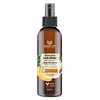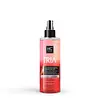What's inside
What's inside
 Key Ingredients
Key Ingredients

No key ingredients
 Benefits
Benefits

 Concerns
Concerns

 Ingredients Side-by-side
Ingredients Side-by-side

Water
Skin ConditioningGlycerin
HumectantAmodimethicone
C11-15 Pareth-7
EmulsifyingLaureth-9
EmulsifyingTrideceth-12
EmulsifyingDimethicone
EmollientCetearyl Alcohol
EmollientPanthenol
Skin ConditioningEthylhexylglycerin
Skin ConditioningPhenoxyethanol
PreservativeBehentrimonium Chloride
PreservativePrunus Amygdalus Dulcis Fruit Extract
Skin ConditioningMusa Sapientum Fruit Extract
Skin ConditioningPersea Gratissima Oil
Skin ConditioningArgania Spinosa Kernel Oil
EmollientButyrospermum Parkii Butter
Skin ConditioningBiotin
AntiseborrhoeicNiacinamide
SmoothingHydrolyzed Vegetable Protein
Skin ConditioningTocopheryl Acetate
AntioxidantPhenyl Trimethicone
Skin ConditioningCocos Nucifera Fruit Extract
EmollientCitric Acid
BufferingParfum
MaskingHexyl Cinnamal
PerfumingWater, Glycerin, Amodimethicone, C11-15 Pareth-7, Laureth-9, Trideceth-12, Dimethicone, Cetearyl Alcohol, Panthenol, Ethylhexylglycerin, Phenoxyethanol, Behentrimonium Chloride, Prunus Amygdalus Dulcis Fruit Extract, Musa Sapientum Fruit Extract, Persea Gratissima Oil, Argania Spinosa Kernel Oil, Butyrospermum Parkii Butter, Biotin, Niacinamide, Hydrolyzed Vegetable Protein, Tocopheryl Acetate, Phenyl Trimethicone, Cocos Nucifera Fruit Extract, Citric Acid, Parfum, Hexyl Cinnamal
Water
Skin ConditioningCyclopentasiloxane
EmollientPEG-7 Glyceryl Cocoate
EmulsifyingPolyquaternium-6
Cetrimonium Chloride
AntimicrobialSodium Cocoamphopropionate
CleansingLaurdimonium Hydroxypropyl Hydrolyzed Wheat Protein
Hydroxyethyl Cetyldimonium Phosphate
Polyquaternium-16
Hydrolyzed Soy Protein
HumectantHydrolyzed Corn Protein
Skin ConditioningHydrolyzed Wheat Protein
Skin ConditioningParfum
MaskingSodium Chloride
MaskingPhenoxyethanol
PreservativeEthylhexylglycerin
Skin ConditioningCI 16185
Cosmetic ColorantCI 19140
Cosmetic ColorantCI 42090
Cosmetic ColorantWater, Cyclopentasiloxane, PEG-7 Glyceryl Cocoate, Polyquaternium-6, Cetrimonium Chloride, Sodium Cocoamphopropionate, Laurdimonium Hydroxypropyl Hydrolyzed Wheat Protein, Hydroxyethyl Cetyldimonium Phosphate, Polyquaternium-16, Hydrolyzed Soy Protein, Hydrolyzed Corn Protein, Hydrolyzed Wheat Protein, Parfum, Sodium Chloride, Phenoxyethanol, Ethylhexylglycerin, CI 16185, CI 19140, CI 42090
Ingredients Explained
These ingredients are found in both products.
Ingredients higher up in an ingredient list are typically present in a larger amount.
Ethylhexylglycerin (we can't pronounce this either) is commonly used as a preservative and skin softener. It is derived from glyceryl.
You might see Ethylhexylglycerin often paired with other preservatives such as phenoxyethanol. Ethylhexylglycerin has been found to increase the effectiveness of these other preservatives.
Parfum is a catch-all term for an ingredient or more that is used to give a scent to products.
Also called "fragrance", this ingredient can be a blend of hundreds of chemicals or plant oils. This means every product with "fragrance" or "parfum" in the ingredients list is a different mixture.
For instance, Habanolide is a proprietary trade name for a specific aroma chemical. When used as a fragrance ingredient in cosmetics, most aroma chemicals fall under the broad labeling category of “FRAGRANCE” or “PARFUM” according to EU and US regulations.
The term 'parfum' or 'fragrance' is not regulated in many countries. In many cases, it is up to the brand to define this term.
For instance, many brands choose to label themselves as "fragrance-free" because they are not using synthetic fragrances. However, their products may still contain ingredients such as essential oils that are considered a fragrance by INCI standards.
One example is Calendula flower extract. Calendula is an essential oil that still imparts a scent or 'fragrance'.
Depending on the blend, the ingredients in the mixture can cause allergies and sensitivities on the skin. Some ingredients that are known EU allergens include linalool and citronellol.
Parfum can also be used to mask or cover an unpleasant scent.
The bottom line is: not all fragrances/parfum/ingredients are created equally. If you are worried about fragrances, we recommend taking a closer look at an ingredient. And of course, we always recommend speaking with a professional.
Learn more about ParfumPhenoxyethanol is a preservative that has germicide, antimicrobial, and aromatic properties. Studies show that phenoxyethanol can prevent microbial growth. By itself, it has a scent that is similar to that of a rose.
It's often used in formulations along with Caprylyl Glycol to preserve the shelf life of products.
Water. It's the most common cosmetic ingredient of all. You'll usually see it at the top of ingredient lists, meaning that it makes up the largest part of the product.
So why is it so popular? Water most often acts as a solvent - this means that it helps dissolve other ingredients into the formulation.
You'll also recognize water as that liquid we all need to stay alive. If you see this, drink a glass of water. Stay hydrated!
Learn more about Water